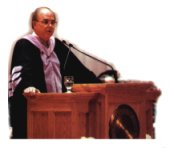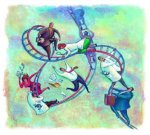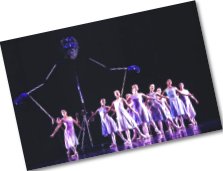
GAZETTE
THE PRESIDENT'S INSTALLATION
 J.
Bernard Machen was formally installed as the thirteenth president of the
University of Utah by State Board of Regents Chair Charlie Johnson in
a ceremony at the Huntsman Center September 25. Setting his own tone for
the celebration, President Machen requested that installation and homecoming
activities focus not on him, but on scholarly and artistic presentations
by faculty and students. "This academic focus demonstrates the vibrant
core of the University," Machen said. "like being associated with such
uplifting activities."
J.
Bernard Machen was formally installed as the thirteenth president of the
University of Utah by State Board of Regents Chair Charlie Johnson in
a ceremony at the Huntsman Center September 25. Setting his own tone for
the celebration, President Machen requested that installation and homecoming
activities focus not on him, but on scholarly and artistic presentations
by faculty and students. "This academic focus demonstrates the vibrant
core of the University," Machen said. "like being associated with such
uplifting activities."
In his inaugural address, President Machen set forth three principles of his administration: the pursuit of excellence, the need and intellectual rationale for diversity, and the primacy of academics. He dedicated his administration to a partnership with his colleagues on the faculty "whose support and guidance are essential to any future accomplishments we might achieve."
In making his case for the importance of education to Utah's future and to society, he observed that a college diploma is much more than a job application. "Work consumes only a small part of one's time. What people do with the non-work part of their lives in large are.
College introduces students to the many outlets available. Whether it is in the museums and libraries, theaters, classes in English literature, music, modern dance, golf, swimming, or the joy of reading books, a college education can open the mind to the wonders of our civilized culture. From such exposure, the pursuits of a lifetime can be born," Machen observed.
The installation also featured salutatory remarks from University Board of Trustees Chair James Jardine BA'71, Utah Governor Mike Leavitt, and Commissioner of the Utah System of Higher Education Cecelia Harrison Foxley MA'65 PhD'68. As is tradition, members of the faculty donned their academic regalia to take part in the ceremony. Machen concluded his remarks with praise for them, and quotations from Wallace Stegner BA'30, who wrote that his Utah professors "...not only had pried open my closed skull but had planted within it an ambition to write....It is ultimately the love of books that I owe them...their influence still works in me...No university...could have done much more."
THE DIFFERENCES BETWEEN US
Utah's large families, coupled with their propensity to keep detailed genealogical records, make genetics and the U a logical fit. This fortuitous connection is but one of many across academic disciplines and between campus and the community which was celebrated during Installation Week.
On September 22, representatives from various disciplines took part in "Genetics, Medicine, Biology, and Bioethics," a three-hour panel presentation. Human genetics professor Lynn Jorde explained how genetic tests are conducted in his overview, a "DNA Primer and Genetic Testing." Guests were provided the opportunity to see a small portion of their own DNA "fingerprints," produced by swabbing a cheek cell sample.
 Also
at the event, biology associate professor Jon Seger moderated a panel
presentation and open forum. Panelists included U faculty members Ray
Gesteland of human genetics, Ray White of oncological sciences, Jeffrey
Botkin of pediatrics, Peggy Battin of philosophy, and Henry Harpending
and Kristen Hawkes, both of anthropology. Professor Gesteland pointed
out how particularly fitting the Installation Week theme of "Connections"
was, noting that genetics is "the ultimate connection among all of us."
Also
at the event, biology associate professor Jon Seger moderated a panel
presentation and open forum. Panelists included U faculty members Ray
Gesteland of human genetics, Ray White of oncological sciences, Jeffrey
Botkin of pediatrics, Peggy Battin of philosophy, and Henry Harpending
and Kristen Hawkes, both of anthropology. Professor Gesteland pointed
out how particularly fitting the Installation Week theme of "Connections"
was, noting that genetics is "the ultimate connection among all of us."
Panelists also discussed the increasing cooperation shown among various fields regarding genetics, saying that one of the goals of the panel was "to show how scientific advancements on seemingly unconnected fronts are actually connected."
Botkin discussed genetics' impact on reproductive medicine and the social issues with which the science is intertwined, venturing, "I think this will rival, or even dwarf, the abortion debate."
Battin talked about genetics helping to define the "size and shape" of our lives. Through these technological advances, we're getting a distinctively new kind of self-knowledge, Battin said. Life expectancies, for instance, are becoming far more predictable. She wondered, however, whether the new knowledge is an advance or a setback in human development, asking the audience, "If you could know the date of your death, would you like to know it right now?"
MAKING ENDS MEET
At a panel discussion sponsored by the Colleges of Fine Arts and Engineering in celebration of President Machen's installation, some of the collaborative work under way between artists and engineers was showcased. The evening's performances and presentations were compelling proof of what can be accomplished by crossing boundaries between disciplines – even those as seemingly disparate as art and science.
Joseph Andrade, director of the Center for Integrated Science Education at the U, whose telecourse, "Science Without Walls," features a segment titled "The World of Science: the World of Art," served as emcee.
Not only do the arts help students visualize and learn scientific ideas, but artists can bring new perspectives to scientific research and facilitate advances in technology, he said, citing the birth of computer graphics at the U nearly 35 years ago as a prime example.
 "David Evans BA'49 PhD'53, founding chair of the department of computer
science, admitted to his graduate program artists and musicians with little
or no formal or scientific training," Andrade explained. Though Evans
struggled to justify his actions to skeptical colleagues, his innovations
in teaching paid off, helping to establish Salt Lake City's reputation
as a center of excellence for computer graphics. "This is indeed the place
as far as computer graphics are concerned," quipped Andrade.
"David Evans BA'49 PhD'53, founding chair of the department of computer
science, admitted to his graduate program artists and musicians with little
or no formal or scientific training," Andrade explained. Though Evans
struggled to justify his actions to skeptical colleagues, his innovations
in teaching paid off, helping to establish Salt Lake City's reputation
as a center of excellence for computer graphics. "This is indeed the place
as far as computer graphics are concerned," quipped Andrade.
Computer graphics have, in turn, enhanced art. Probably the most visible domain of this curious marriage of art and technology is the film studies program, said its director, Brian Patrick, in his introduction to a three-minute computer-animated short film produced by film students of adjunct professor Dale Angell. The five student animators who collaborated on the movie spent six months on the project. Students James Jacob, Karri St. John, Mitch Stevens, Kris Hammond, and Zoya Maslak were required to create the film for Angell's 1996 spring computer animation class. Most are now working professionally in computer animation.
"Advances in computerized editing and high-tech computer animation... have made filmaking easier, faster, and cheaper," said Patrick. "And the best part is the finished work looks so much better." "Fish Wars," which has been featured at film festivals around the world and has received four awards, including Cine's prestigious Golden Eagle Award, wouldn't have been possible without advances in computer graphics and the SGI computers housed at the U's Super Computing Institute, said Angell.
Computer graphics also have applications in science and medicine at the U. Chris Johnson MS'84 PhD'90, computer science professor and director of the U's Center for Scientific Computing and Imaging, discussed some of the projects being undertaken in collaboration between the center and medical scientists at the University Hospital.
"Through the ages, science has gone from looking at the form, to the function of the human anatomy," he said. Computer visualization in medicine has evolved from Xrays and microscopes, which allowed doctors to observe physiological states, to high-performance supercomputing and advances in algorithms in computer science, which now enable medical scientists to identify and better understand complex physiological processes.
This past March, Johnson and his colleagues were approached by radiologists and neurosurgeons from the U hospital with a patient suffering from a large brain aneurysm. The doctors needed to map precisely the location of the aneurysm in relation to the brain's arteries in order to determine the best way to reach and surgically remove it. Johnson took the data from the scientists' enhanced, high-resolution magnetic resonance images and was able to "virtually" remove the scalp, skull, and brain to isolate only the arteries. "The patient survived the operation. It was one of the largest aneurysms ever removed," said Johnson, who envisions that, as with computer-simulated flight for pilots and astronauts, computer visualization will one day enable doctors to perform surgery in a simulated environment before actually performing the real thing.

Guest artist Ellen Bromberg, assistant professor Rick Wacko of the dance department, and engineering student Josh Gray demonstrated how advances in interactive media and animatronics are changing art forms as old as dance. Bromberg's electronically wired "intelligent stage," which gives dancers extraordinary control of their music and stage, and Wacko and Gray's 16-foot mechanically engineered puppets to be used in the Utah Ballet's December production of The Snow Maiden demonstrated that the result of dissolving boundaries between art and science is a palpable shift in society's perception and understanding of the world.
HEADY THOUGHTS ON HOT AIR
Global warming may or may not be real, but one thing is certain: The debate itself has generated plenty of heat.
 U
geologist David Chapman explored that hot topic when he presented the
seventh annual William R. and Erlyn J. Gould Distinguished Lecture on
Technology and the Quality of Life. The lecture was part of Installation
Week activities at the U. The Gould Distinguished Lecture, now in its
seventh year, is an annual address designed to help the general public
understand the contributions of engineers and scientists.
U
geologist David Chapman explored that hot topic when he presented the
seventh annual William R. and Erlyn J. Gould Distinguished Lecture on
Technology and the Quality of Life. The lecture was part of Installation
Week activities at the U. The Gould Distinguished Lecture, now in its
seventh year, is an annual address designed to help the general public
understand the contributions of engineers and scientists.
Chapman's lecture, "Global Warming:Just Hot Air?", attempted to answer four questions involving the global warming debate: What do we know? What don't we know? What can we do? What should we do? Chapman is a pioneering scientist in the field of global warming. He and his students have used bore holes drilled deep into the ground to study temperature fluctuations in the Earth's strata. This and other data allow scientists to trace warming and cooling episodes on the planet's surface over the past 400 years in an effort to better understand changes in the global environment.
He believes that the evidence for global warming is strong, but the cause of the warming hasn't been proved conclusively. With the potential damage warming may cause, however, he wonders if we need much more than a reasonable suspicion.
"If you feel comfortable running this kind of experiment with planet Earth you're much more sanguine than I," he said.
The geology professor and administrator also said that humans have "messed up the planet," and he wonders if they can now save the planet. If global warming turns out to be the "smoke alarm" that forces us to look at issues like population and energy consumption, then global warming may turn out to have had a positive effect, he concluded.
STIGMAS AND STEREOTYPES
Should society offer special preferences to minority group members, or should it become globally colorblind, as Utah, and the rest of the world, moves into the 21st century?
"Continuing problems of race and gender are among the most compelling and difficult issues our society faces today," Utah law professor Robert Flores noted at the panel discussion, "Diversity: Critical Issues for the 21st Century," during Installation Week at the U.
 To
keynote speaker Richard Delgado, professor of law at the University of
Colorado, programs like affirmative action really mirror the social advantages
which have been afforded to whites for centuries. Since many whites have
benefited from favors, courtesy, and connections, Delgado asks, why shouldn't
minorities receive similar consideration in educational admissions through
affirmative action? The program's "benefits are practically self-evident,"
he asserted, before refuting 10 arguments commonly used to oppose affirmative
action. He noted that in providing special consideration of minority applicants,
higher education officials can offset racial bias in standardized testing
and provide opportunities for students whom the educational system might
otherwise exclude. If policy makers eliminate all race- or gender-based
criterion by becoming colorblind, he asked, are we erasing the very qualities
that make us unique? Will neutrality really make us all equal in the workplace
and in our schools?
To
keynote speaker Richard Delgado, professor of law at the University of
Colorado, programs like affirmative action really mirror the social advantages
which have been afforded to whites for centuries. Since many whites have
benefited from favors, courtesy, and connections, Delgado asks, why shouldn't
minorities receive similar consideration in educational admissions through
affirmative action? The program's "benefits are practically self-evident,"
he asserted, before refuting 10 arguments commonly used to oppose affirmative
action. He noted that in providing special consideration of minority applicants,
higher education officials can offset racial bias in standardized testing
and provide opportunities for students whom the educational system might
otherwise exclude. If policy makers eliminate all race- or gender-based
criterion by becoming colorblind, he asked, are we erasing the very qualities
that make us unique? Will neutrality really make us all equal in the workplace
and in our schools?
No, said panelist Sofia Villenas, professor of educational studies and ethnic studies. Colorblindness, which implies equality, is meaningless if people are still dehumanized through poor treatment and discriminatory labels, she said. Other panelists commenting on Delgado's address included Professor Mark McPhail, communication; Professor Ileana Porras, law; and Robert Caserio, visiting associate professor of English.
Clearly, the debate on affirmative action policies, which goes hand in hand with diversity issues, will continue well into the next century. And it may take on special relevance at the U, where diversity must be encouraged, according to new U President Bernie Machen.
"We need to bring individuals from diverse ethnic and racial backgrounds so as to enrich the discussion and debate that takes place here," he said in his inaugural address. "For the best ideas to flourish, many diverse opinions need to be aired."
feedback from elementary school students on plans for a nature project in the Poplar Grove community.
In a time when higher education's value, especially in Utah, is under increasing scrutiny, sharing and gaining knowledge through service may be one of the most important yardsticks of the value of higher education, panelists submitted.
CONTRACT WITH COMMUNITIES
Measuring a university's merit by focusing on teaching hours, tuition costs, and faculty research is one means by which to determine a school's value. It is not, however, the best system for gauging a university's contributions to society, a society whose needs, demographics, and lifestyles are rapidly changing, according to proponents of learning through service.
"We need to form a new social contract with the communities we serve," asserted Irwin Altman, distinguished professor of psychology, as he introduced "University and Community Connections Through Service and Learning," a panel held during Installation Week.
"It's our responsibility to carve out what the new system of higher education should look like," Altman noted. Gone are the days when education meant learning critical and conceptual skills alone. Today's students must also be given the social tools to bridge the gap between the halls of higher education and society.
Through service learning classes at the U, pharmacy students have coupled their knowledge with listening skills acquired while visiting senior citizens who could be their future clients. Architecture students have received
U REPS TALK THE TALK
More than 100 University professors, doctors, administrators, graduate students, and staff members are taking their expertise out of classrooms and into the meeting places of area civic groups, clubs, organizations, and schools through the University's new Speakers Bureau.
Launched last fall, the U Speakers Bureau links academic professionals with community groups who would like to learn more about astronomy, family communication, evolution, gangs, medical issues, or a variety of other topics, in a casual setting.
"We want to share the vast amount of knowledge we have here at the U with the community, while at the same time providing opportunities for people to better know our faculty, staff, and graduate students," says Speakers Bureau Coordinator Allyne Betancourt.
The speakers, their areas of interest, and their biographies are listed on the bureau's home page (www. utah.edu/speakers). Speakers are scheduled, depending on availability, through Betancourt at least four weeks in advance. For more information, contact her by e-mail at allyne@unicomm.utah.edu, or by phone at 581-6773.
| IN MEMORIAM
James C. Bapis, 64, BS'58, award-winning news and science writer at the University of Utah for more than 22 years, and reporter for United Press International. He was elected to the National Association of Science Writers in 1991. Iver Edwin Bradley, 77, BS'47, professor of economics and management, and director of the Institute of Technical Training at the U. He later became the University's ninth dean of the College of Business and the Graduate School of Business. Ed also served for a time as commissioner for budget and finance with the Utah System of Higher Education. David C. Evans, 74, BA'49 PhD'53, founder and former chair of the Department of Computer Science, and cofounder of Evans & Sutherland Computer Corp. Evans was a renowned champion of interdisciplinary education. T. Benny Rushing, 56, popular former dean of the University of Utah College of' Science. Rushing also served two terms as chair of the Department of Mathematics at the U. During his tenure in 1993, the U's Department of Mathematics was named the nation's most improved mathematics department by the Conference Board of Associated Research Councils. Dr. Roger R. Williams, 54, a recognized expert in the field of cardiovascular genetics and professor of internal medicine at the University of Utah School of Medicine, died in the crash of a SwissAir jetliner off the coast of Nova Scotia. He founded the University of Utah Cardiovascular Genetics Research Clinic. |
Copyright 1999 by The University of Utah Alumni Association